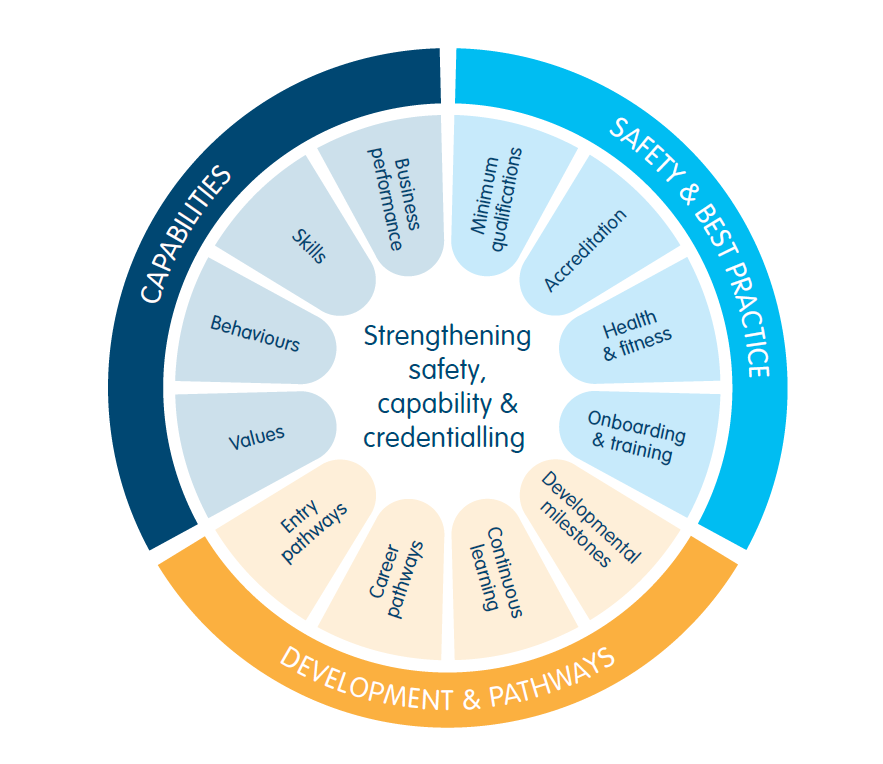INTRODUCTION
This National Aquatic Workforce Framework is an initiative of Royal Life Saving and the National Aquatic Industry Committee. It's primary purpose is to provide a resource to the industry which strengthens the attractiveness of employment in aquatic facilities, provides resources and guidance to strengthen systems and supports that encourage greater retention of talent and to advocate a variety of career pathways available to those working in aquatic facilities.
The framework aims to:
- Serve as a resource to improve attractiveness to the industry and retention of talent
- Better articulate the many career opportunities available in the sector
- Bring clarity to the competencies and capabilities required for key roles
- Promote aquatic careers
- Define clear pathways for professional growth
- Encourage standardising systems for safety outcomes (such as licensing / accreditation)
- Supporting the sector (as applicable) in effective workforce planning / training package design
Scope
The framework specifically targets roles integral to water safety and drowning prevention, such as pool lifeguards, swim teachers, customer service staff providing safety information, aquatic coaches, aqua exercise instructors, and their management lines. It deliberately excludes fitness professionals in gyms, sports professionals in stadiums, and other non-aquatic roles found in aquatic facilities and recreation centres.
FRAMEWORK RESOURCES
CAREER SPOTLIGHTS
BACKGROUND
The National Aquatic Workforce Framework responds to the calls in the Australian Water Safety Strategy for greater advocacy on career pathways and enhancing professional development systems for the aquatic workforce, four national symposia where delegates called for greater resources and advocacy on workforce capabilities, development and pathways and three separate research reports conducted by Royal Life Saving Australia into the state of the national aquatic workforce.
It builds upon existing safety and operational guidelines and seeks to go ‘beyond the qualifications’ detailing the full depth and breadth of capabilities workers in the aquatic industry require in order for the industry and the communities it serves to thrive.
At the National Aquatic Workforce Symposium in March 2024, convened by Royal Life Saving Australia, over 50 delegates from diverse industry segments came together. This gathering was crucial in addressing workforce challenges and shaping a national strategy based on comprehensive research and previous symposium insights.

USING THE FRAMEWORK
The framework serves as a guide, advocating for best practices rather than prescribing specific approaches for individuals or organisations. It encourages the aquatic industry to apply or adapt its components to enhance workforce safety, capability, adaptability, and leadership. By documenting capabilities and advocating for clear career pathways, it seeks to broaden participation in the sector, supporting both organisational objectives and personal career aspirations.
FEEDBACK & CONSULTATION
The draft framework was released on the 22nd May 2024 for a one-month period to obtain industry and expert feedback and consultation via the website.
The framework was published following consultation on 15th July 2024 and Royal Life Saving Australia seeks to continue development on the framework to respond to the dynamic nature of the aquatic industry and continue to grow with the workforce.
If you would like to provide feedback, request support using the framework or even tell us how you are already using the framework in your business or workplace please contact us directly by email.
Royal Life Saving will seek to monitor the success and validity of the framework through ongoing research into the aquatic workforce. Read more clicking below.
Report methodology and background presentation
On the 22nd May 2024, Royal Life Saving hosted a webinar discussing the background to the framework and why it is important.
The webinar recording is available in the GSPO Subscriber area of the website here:
